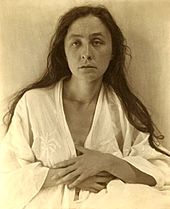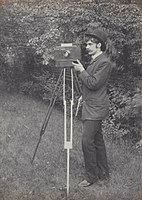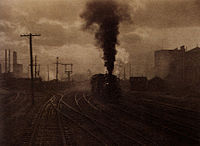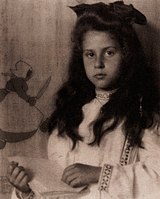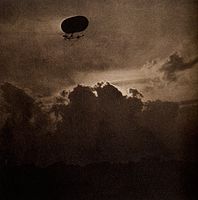Alfred Goldfinch

Alfred Stieglitz (born January 1, 1864 in Hoboken , New Jersey , † July 13, 1946 in New York ) was an American photographer , gallery owner and patron . He was one of the most important people who presented the American public with influences of the European avant-garde on American art. To this end, he used his work as editor of the magazine Camera Work , with which he wanted to promote photography and legitimize it as an art form. In addition, he was director of the famous " Galerie 291 " and then the "Intimate Gallery" and "An American Place". He presented many of the most outstanding photographs of his time in both the magazine and the galleries.
Live and act
Alfred Stieglitz, born in Hoboken, New Jersey, was the first son of the German-Jewish immigrants Edward Stieglitz (1833–1909) and Hedwig Ann Werner (1845–1922). His brothers were Leopold and Julius Stieglitz . In 1880 he traveled through Europe and took photos in many places. He studied mechanical engineering in Berlin from 1882 and was able to benefit from Hermann Wilhelm Vogel's knowledge in photography as a student . At the age of 24 he was awarded first prize in a British photography competition in which PH Emerson was one of the judges. This became the first of a good 150 medals that he was to receive in his life.

In 1889 Stieglitz moved to New York , where he began to make his work available to a wide audience, wrote about photography and was accepted as an honorary member of The Linked Ring community . His early works were mainly influenced by Pictorialism , as we knew it from France and England.
In 1893 he married the brewery heiress Emmeline Obermeyer (1873–1953), who was nine years his junior; in 1898 a daughter, Katherine (Kitty) was born. The fortunes of his wife and parents enabled him to live without worrying about livelihood.
In 1902, Alfred Stieglitz founded the “ Photo Secession ” and opened his first gallery. In his own works, he soon rejected any form of manipulation such as retouching and instead often photographed in rain, fog or snow in order to achieve the desired soft contours and effects and to show that the right view is more important than just the equipment or the external conditions. His most famous photos from this period are probably The Terminal (1892), Winter on Fifth Avenue (1893) and Flatiron Building (1902/1903). According to his own statements, for Winter on Fifth Avenue he stood in the freezing cold for more than three hours on the street, waiting for the right moment. In Flatiron Building he saw a symbol for the up-and-coming America, which at that time was in a state of upheaval that could not pass art by without a trace.
The magazine Camera Work , which appeared four times a year and was founded by Stieglitz in 1903, existed until 1917 and contained photographs as well as reviews and reproductions by avant-garde artists. In 1905, Alfred Stieglitz and Edward Steichen founded the “ Galerie 291 ” (named after their address: 291 Fifth Avenue), where artists such as Georgia O'Keeffe , Matisse , Cézanne , Rodin , Braque , Hartley , Marin and Dove exhibited. Stieglitz asked O'Keeffe to model for him, and the first photos were taken with her as a subject. An intense love affair developed between the two, during which Stieglitz divorced in 1918 after 24 years of marriage to Emmeline Obermeyer. From 1918 to 1937 Stieglitz made over 300 photographs of O'Keeffe. They married in 1924.
From 1922 Stieglitz often photographed cloud formations, which he called “equivalents” and regarded as symbols of his philosophy of life.
After the end of “Galerie 291”, Camera Work and “Photo-Secession” in 1917, which were given up for financial reasons due to the First World War , Stieglitz opened the “Intimate Gallery” (1925–1929) and “An American Place ”(1929–1946), where mainly paintings, sculptures and graphics were exhibited. His later work includes countless studies by Georgia O'Keeffe (he photographed them from over 900 different perspectives) and views of New York, among other works.
The group of intellectuals that had gathered around him in the first quarter of the 20th century had a decisive influence on the artistic development in America and became known around 1913 through the world-famous " Armory Show ". Stieglitz 'work also inspired writers such as William Carlos Williams , who also dealt with precisionism and knew Stieglitz personally. Thus at that time the visual and literary arts reached hand and were united like seldom afterwards.
Alfred Stieglitz and Georgia O'Keeffe's written and artistic legacy is kept in the beincke Rare Book and Manuscript Library in New Haven, Connecticut .
Works (selection)
Exhibitions
- 2011: Stieglitz, Steichen, Strand . Exhibition at the Metropolitan Museum of Art in New York City from November 10, 2010 to April 10, 2011
- 2012: New York Photography. From Goldfinch to Man Ray . Exhibition at the Bucerius Kunst Forum , Hamburg, from May 17 to September 2, 2012
- 2015/16: Masterpieces & Curiosities. Alfred Stieglitz's The Steerage . Jewish Museum , New York, September 25, 2015 to February 14, 2016
literature
- Julia Krumhauer (Ed.): Stieglitz Camera Work . Taschen Verlag, 2008, ISBN 978-3-8228-3784-9 .
- Sarah Greenough: The Alfred Stieglitz Collection of Photographs at the National Gallery of Art, Washington, Volume I & II ; Harry N Abrams, 2002, ISBN 0-89468-290-3 .
- Alfred Goldfinch . Könemann, Cologne 2002, ISBN 3-89508-607-X .
- R. Scott Harnsberger: Four artists of the Stieglitz Circle: A sourcebook on Arthur Dove, Marsden Hartley, John Marin, and Max Weber . Greenwood Press, 2002, ISBN 0-313-31488-8 .
- Sarah Greenough: Modern art and America: Alfred Stieglitz and his New York galleries . National Gallery of Art (Ed.) By Little, Brown and Company, 2001, ISBN 0-8212-2728-9 .
- William Innes Homer: Alfred Stieglitz and the Photo-Secession . Little, Brown and Company, Boston 1983, ISBN 0-8212-1525-6 .
- Robert Doty: Photo-Secession: Stieglitz and the Fine-Art Movement in Photography . Dover Publications Inc., 1978, ISBN 0-486-23588-2 .
- William Innes Homer : Alfred Stieglitz and the American Avant-Garde . Secker & Warburg , 1977, ISBN 0-436-20082-1 .
- Sadakichi Hartmann: Alfred Stieglitz . In: Photographische Rundschau , 14th year, Knapp, Halle / S., 1900, p. 237 ff.
- Phyllis Rose: Alfred Stieglitz: taking pictures, making painters , Yale University Press, New Haven 2019, ISBN 978-0-300-22648-5
Web links
- Literature by and about Alfred Stieglitz in the catalog of the German National Library
- Alfred Stieglitz on kunstaspekte.de
- Alfred Stieglitz at photography-now.com
- Alfred Stieglitz: Known and Unknown ( Memento from December 26, 2002 in the Internet Archive ) in the National Gallery of Art (English)
- Alfred Stieglitz in the collection of the George Eastman House (English)
Individual evidence
- ↑ Wolfgang Baier: Source representations for the history of photography . 2nd edition, Schirmer / Mosel, Munich 1980, ISBN 3-921375-60-6 , p. 533
- ↑ Alfred Stieglitz. Retrieved December 20, 2015 .
- ^ Alfred Stieglitz / Georgia O'Keeffe Archive , beinecke.library.yale.edu, accessed January 19, 2013
| personal data | |
|---|---|
| SURNAME | Goldfinch, Alfred |
| BRIEF DESCRIPTION | American photographer, gallery owner and patron |
| DATE OF BIRTH | January 1, 1864 |
| PLACE OF BIRTH | Hoboken , New Jersey |
| DATE OF DEATH | July 13, 1946 |
| Place of death | New York City |

